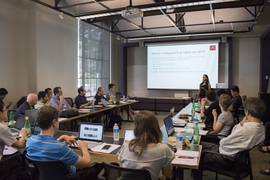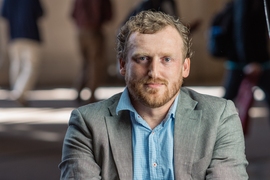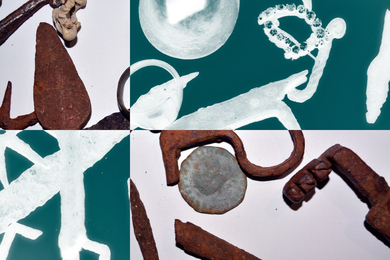Imagine you give up everything you have to escape war, persecution, or violence. Of the 65 million refugee and internationally displaced people, many are children. Already suffering from upheaval and stress, these children deserve the right to continue their education, but how can this be accomplished?
Last fall, MIT launched Solve: Learn, one of four focus areas under the MIT Solve initiative that aims to help solve world challenges by bringing together leaders from the private, public, nonprofit, and academic sectors to partner, fund, and implement promising solutions. Through an open innovation online platform, the Learn challenge is designed to bubble up impactful and scalable solutions to improve learning outcomes and provide a quality education to refugee children around the world.
This summer, 62 applicants answered the call to improve refugees’ educational plight by posting their novel learning ideas to the Solve CoLab crowdsourcing platform. And on Sept. 28, as part of Solve at HUBweek, three top solutions were selected from the six international semifinalists who presented their proposals to a room full of private, non-profit, and academic leaders, including many from MIT. This first wave of Solve: Learn finalists will receive support from Solve and its partners, with the goal of funding, piloting, and implementing their solutions, and presenting at the flagship Solve at MIT event, which will take place in spring 2017.
“I came to the Solve: Learn session to learn more about the refugee education solutions being put forward,” said Christine LeViseur Mendonça, co-founder of Humans on the Move. “I am excited to see the ones that moved forward. At Humans on the Move, we are looking for solutions that we can connect with our partners, and I appreciated that there was a solution that was selected that was already helping refugees as well one that was in idea phase. I will definitely be back in the spring, as well as encourage education solutions innovators that we meet to apply when the Solve CoLab platform reopens in October.”
The preliminary round of judges for this Solve: Learn challenge included MIT Department of Civil and Environmental Engineering (CEE) Esther and Harold E. Edgerton Career Development Professor Admir Masic, who serves as the Learn challenge leader; CEE professors Franz-Joseph Ulm and John Williams and CEE postdocs Sarah Safieddine and Francisco Martinez, who helped evaluate the proposals; Solve Executive Director Alexandra Amouyel; Rudayna Abdo from Thaki; Kavita Gupta from the Schmidt Family Foundation; Hala Fadel from Leap Ventures; and MIT Media Lab research scientist Philipp Schmidt. MIT Technology Review editor-in-chief and publisher Jason Pontin served as emcee for the event.
A personal investment
This educational infrastructure challenge is very close to Masic’s heart, because he spent his early teens in a Croatian refugee camp during the Bosnian War of 1992.
“My early schooling was interrupted when I became a refugee,” he said, “and I was not allowed by Croatian law to access its public educational system. I literally stumbled upon a high school one day with my mother and only when we pleaded our case was I allowed to sit in back of some of the classes. This lucky break is a major reason I was able to ultimately advance my education and be here on MIT’s faculty.”
He added, “I look at current situation of global refugees and am compelled to take action. We need to go beyond obstacles and deliver the quality education that these millions of young and forcibly displaced people need.”
Not surprising, many of the solutions presented involved incorporating technology and engineering solutions that may originally start in one country, but can quickly grow to global scale.
“We must imagine new models and modes of learning to reach those who do not have access to quality education, and for that we should use the talent, ingenuity, and experience of all who would like to participate. Which is why one of Solve’s core values is open innovation and that anyone — hopefully even refugees themselves — can participate on the Solve CoLab platform,” said Amouyel. “If we can provide willing learners with fundamental tools like critical reasoning and creative thinking, they can achieve their full potential, and contribute to change our world for the better.” She emphasized that we must understand this challenge in the context of the economic, cultural, and political barriers to a quality education.
The winning finalists that will go on to compete were: “A Blended-Learning Higher Education Model for Refugees,” submitted by Kiron Open Higher Education; “Team Up to Teach,” submitted by Problem Solvers Without Borders; and “Crowd-sourced Education Platform for Refugees Around the World,” submitted by Gail Anderson ’88.
Maintaining the course for college
Kiron’s winning blended-learning solution involves providing two free years of online study before refugee students can transition to a traditional college or university. During the program’s online phase, students follow one of three curricula. Kiron has already established a partnership to provide this online training with edX, a non-profit, open source online global education course provider founded by MIT and Harvard.
Kiron’s first cohort of 1,500 refugee students is based in Germany with additional pilot programs underway or soon-to-be-introduced for another 1,500 youth refugees in France, Jordan, Turkey, and potentially Lebanon. Acacia Landfield, who presented the team’s proposal, explained that its solution involves a global network of volunteers and does not require school transcripts up front — a good thing, since many refugees flee their home countries quickly, often without much of anything, let alone proof of education.
Landfield said online courses are complemented with physical and direct online tutoring and offline services — translation support, a buddy program, a mentoring program, study hubs, and career services — provided through staff and a global network of volunteers. European partners include major corporations such as BMW, Eurasmus, and high-level government supporters. Although the program currently supports only teenagers interested in higher education opportunities, the group’s plan is to scale the program eventually to include younger children.
“Our team’s goal is to empower refugee students to lead self-sufficient lives,” said Landfield.
Embodying “mens et manus” (“mind and hand”)
Gail Anderson ’88, an MIT aerospace engineer turned math teacher, proposed a crowd-based solution as an early submission to the effort. She said her experience working with refugees at a Yugoslavian camp in 1987 helping those escaping from Bulgaria and Romania inspired her to take action given the global refugee crisis today.
Her proposal, titled “Crowd-sourced Education Platform for Refugees Around the World,” is to create an online portfolio for refugees so that their credentials, and the courses and they have taken — whether online or in a traditional educaional setting — can stay with them wherever they go. The online platform would also serve to pair them with remote instructors and mentors.
“As a teacher myself, I want to help children grow, inspire curiosity, and build knowledge. I believe there are hundreds of volunteers worldwide who want to donate their time to share their knowledge or mentor a child online.”
She suggested recruiting technology talent, such as MIT students looking for summer projects, to code an open source online mobile learning management system that could eventually grow and scale within and across larger communities. Each student would then be able to connect with a remote mentor, who could guide them by providing feedback and validate learning ideas. She suggested students should also have the support to create and maintain an online lesson portfolio that could validate their personal accomplishments in school and documentation for what they have learned for a lifetime.
“The best part of creating an online portfolio is to give the student something they can be proud of,” said Anderson, “someone no one can take away from them. I believe we can start reaching them now one by one, and then leverage the power of crowdsourcing to reach millions. And with more and more volunteers, we can find those teachers who have different language translation skills to offer.”
“I understand Solve is designed to bring people together who have new ideas so we can learn from each other. By putting us all together in the same room to discuss design and implementation, and through the convening power of MIT to get the resources needed, we are more apt to come up with the best, most viable solutions.”
Frontlines of lesson planning
The “Team Up to Teach” proposal was presented by Kathryn Zaniboni from Problem Solvers without Borders. She quoted a UNICEF statistic that shows one in five refugees is a child who most often is educated by non-professionals volunteering in camps. Many volunteers have stepped forward to offer their time and talents to this vast, growing underserved population, but more needs to be done to improve quality.
“I’m one of those volunteers who works now in a refugee camp in Bulgaria, and I struggle with this responsibility,” she said, adding she particularly struggles to prepare lesson plans for her students, especially given she is not trained as a teacher and doesn’t speak the local language. Further, she said, volunteers educating refugees in Bulgaria have little to no connection or coordination with peers in other countries such as Greece, Belgium, or Germany, further limiting the ability to share ideas, foster efficiencies, and globally scale successful initiatives. “Team Up to Teach” wants to prototype an online platform and bring volunteers in refugee camps as well as qualified teachers all around the world to share their best practices, educational content and lesson tips “virtually.”
“Right now, every time I have a class, I first go on the internet and look for things to teach my students,” Zaniboni explained. “Yet, I have so many friends and networks of teachers that say to me 'how can we help?' So an immediate practical application would be to bring in their expertise virtually. For example, we’re trying to develop more play-based learning, but camp space is limited, and we don’t have a lot of sports equipment available. A teacher online recommended I set up plastic cups and have young children develop their fine motor skills by throwing items into the cups using underhand and overhand techniques. I would never think of that myself.”
She added that ultimately, the strategy would be to develop and grow partnerships with the local schools, but this virtual “team up” approach represents a positive interim solution.












